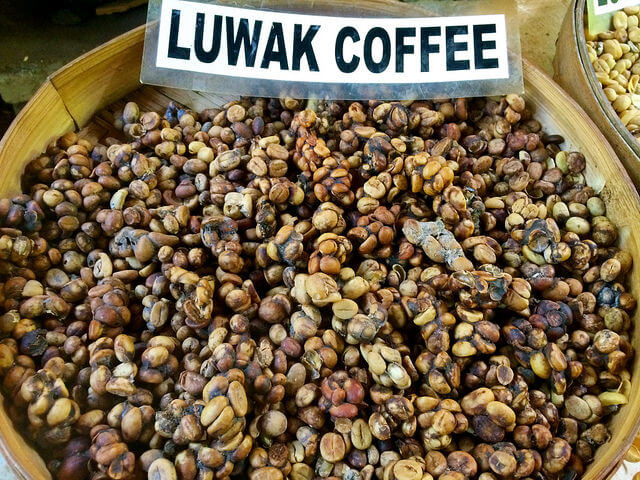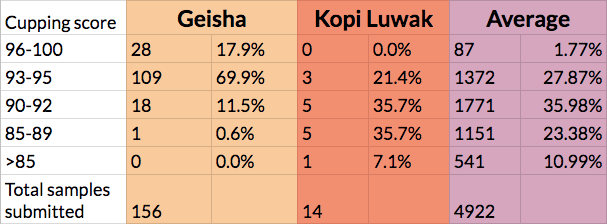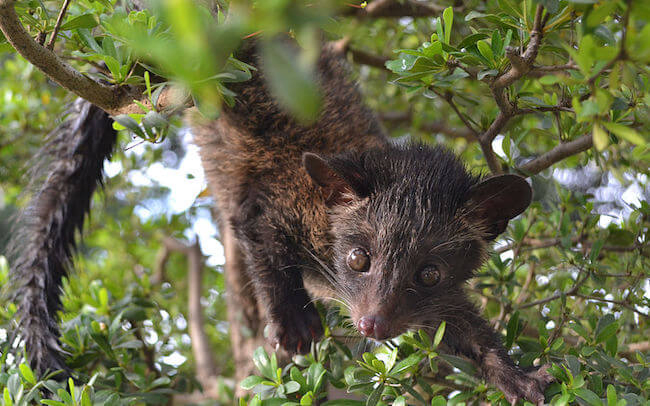It’s funny how some urban legends just catch on and become mainstream truths.
You have probably heard some of them before:
- Ostriches bury their head in the sand when scared
- Einstein failed math in high school
- Bulls are enraged when seeing the color red
- etc
Of course, none of these are true. If ostriches bury their head in the sand, they would either die of asphyxiation or get eaten by predators. Soon the species would be extinct.
Upon closer examination, none of these claims make any sense whatsoever. Still, myths like these persist.
Coffee myths: Enter Kopi Luwak
The same is also true in the realm of coffee. In fact, there are many widespread coffee myths and misbeliefs (I’ll address those in a separate post).
But there is one false conception that is so widespread and long-lasting that no matter of debunking seems to work. And that is that the ‘kopi luwak is the best/most expensive coffee in the world myth.’
I can’t count how many times people have asked me about my opinion of kopi luwak.
It’s a paradoxical situation because to any common sense person it should be evident that we’re talking about an urban legend.
Would you think that any food or beverage would taste better after being mixed with – ahem – shit? If that’s not the case, why do you think that coffee is somehow different?
Still, it seems that about 99 percent of the world’s population want to believe the kopi luwak hype.
I know it probably won’t change much, but this is my attempt to break the world’s delusions and set the record straight.
The origins of cat poop coffee
To understand how kopi luwak came to prominence we need to take a brief historical detour. Back in the 1600’s the coffee market was very different from today. One of the most prominent origins was the Dutch East Indies – a group of islands that is today known as Indonesia.
Indonesia was the first country besides Ethiopia and Yemen, where coffee was grown on a large scale, and at one point the island of Java became almost synonymous with coffee in Europe.
But by 1830 the Dutch created a more strict set of rules governing agriculture in the colony. This meant that the native farmers, who were already accustomed to drinking coffee, were suddenly no longer allowed to pick any beans for their own use.

Somehow these caffeine-craving coolies discovered that a small cat-like animal – the palm civet aka the ‘luwak’ – ate the coffee cherries and passed the seeds without digesting them.
The workers were pretty smart, and the Dutch never forbid collecting dung. It didn’t take long before they began collecting, roasting and brewing these defecated beans, so they could get their caffeine fix.
The ‘processing argument’
Back then coffee picking standards and processing weren’t anywhere close to those of today.
When picking coffee, it’s critical to only go for cherries that are perfectly ripe. As with any other fruit, this ensures that the sugar level is at its peak.
Animals prefer ripe fruits so there is something to suggest that the wild palm civet might have been more selective than the laborers at the Dutch-owned estates. But this is speculation.
Coffee processing, in its essence, is all about stripping away the fruit while avoiding the development of mold.
Strictly speaking, 30 hours in the stomach of an animal would do precisely that.
It is possible that this combination of carefully selected cherries and efficient processing made the coffee superior to anything available back then. However, it’s worth remembering that the general standard of processing wasn’t anywhere close to those that are employed by specialty coffee producers today.
The marketing begins
One of the first rules of marketing is to turn a thing that can be perceived as a fault into a feature. This is precisely what happened next.
Kopi Luwak quickly gained attention from the colonial overlords.
An idea spread that the coffee was somehow ‘smoother’ than regular coffee
Due to the somewhat limited supply of kopi luwak, high prices could be fetched when exported. Still, this kind of coffee wasn’t big business, and when large-scale commercial coffee production took off other places besides Indonesia, interest in kopi luwak faded.
But then in 2007 something crucial happened: Kopi luwak was mentioned in the movie ‘The Bucket List’ featuring Jack Nicholson and Morgan Freeman.
The interest once again soared, and sneaky businesspeople were quick to exploit the craze. Suddenly, a bunch of coffees in South East Asia had a kopi luwak stamp on the top of the packaging even though they had never been anywhere near cat poop.
With a bit of marketing, a horrid robusta bean could be sold at a premium many times higher than before to gullible tourists who believed that they had bought the ‘best coffee’ in the world.
But that wasn’t the worst part. It turned out that some farmers in poor coffee producing Asian countries suddenly began capturing civets to force feed them the cherries.
From Civet to monkey and Elephant poop
Civets are omnivores and eat everything from fruits to insects. It goes without saying that coffee cherries shouldn’t make up the majority of their diet as caffeine affects animals the same way as humans.
This way of producing coffee is not just stupid; it’s also outright animal cruelty.
In recent years, similar coffees have emerged in both South America and the rest of Asia. Monkey poop coffee and black ivory coffee ‘digested’ by elephants are some of the more notorious types.
There are many crazy ideas out there. And for good measure, I should of course also mention that cats can’t drink coffee!
Beans quality is important
In the previous sections, we talked about why kopi luwak might have been better than other coffees available in the colonial era, albeit not good compared to the coffees of today.
But talking about quality in this kind of terms might be confusing. So let’s try to be more accurate.
When somebody might say “kopi luwak is the best coffee in the world” what they are talking about is, in fact, a particular kind of processing and not a specific botanical variety (i.e type of coffee).
In South East Asia, where most luwak coffee comes from, you can find a wide range of coffee varietals – from high-quality arabica to low-grade robusta – grown at different altitudes.
Even though after-harvest processing is a crucial aspect of producing premium coffee, other factors are equally important.
To be entirely fair you would have to compare kopi luwak to the ‘washed’ or ‘natural’ process. But this is absurd. Nobody who works with coffee professionally would ever say that the best coffee in the world is washed. That would be like saying that the best wine is red wine; a statement so broad that it would be void of any meaning. The truth is that there’s both excellent and nasty washed coffee.
Animal poop coffee is shit – literally

Looking at cat shit coffee in this manner, it becomes evident that it’s merely a colorful marketing ploy to fool gullible coffee drinkers.
Still, wouldn’t it be fun to see how this kind of coffee compares against the other types?
This is precisely what I have done in my article about the best coffee in the world. In that piece, I try to study coffee based on statistics. What immediately becomes apparent is that kopi luwak is actually of a lower quality than the average specialty coffee. You can read the full post here.
My results are backed up by the fact that no winners of any of the most prestigious coffee tournaments in the world have ever used kopi luwak.
But why?
So how come this myth still persists? Well, for the same reason that kopi luwak made it into a movie in the first place.
It’s the definition of clickbait itself. It’s too much fun to not mention at the water cooler or to share on your favorite social media.
In a sense, it’s not that much different from the stories about Einstein and Ostriches.
How can we stop this stupid idea? Well, you can go ahead and share this article on your favorite platforms. It might be a bit of a party killer, but if that is what it takes to save animals and raise the quality levels of the coffees tourists in Indonesia consume, I’m fine with that.
